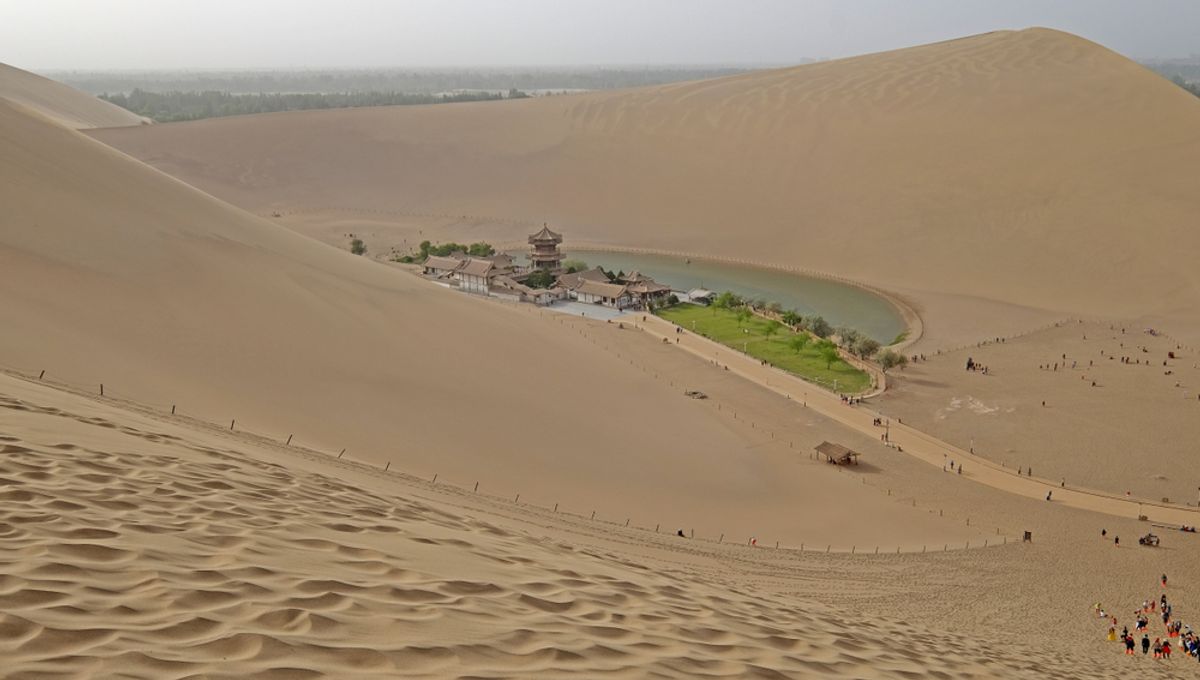
In China’s northwestern Gansu Province, the city of Dunhuang’s desert hills are alive with the sound of music. A fascinating, and somewhat eery, phenomenon causes the staggeringly high sand dunes scattered throughout the Kumtag Desert to “sing” in the wind.
The Singing Sand Dunes range in size, with the highest peak reaching 1,715 meters (5,626 feet). If you look closely, the sands are even rainbow-colored, ranging from yellow and white, to green and black.
Although not unique to Dunhuang, the musical dunes in this region are the center of many Chinese legends and folklore. The dunes are situated along the famous Silk Road, a significant trade route running between Central Asia and Europe that was used for around 1,500 years from the second century BCE. The significance of their location has meant that these dunes in particular are some of China’s most culturally significant singing sand dunes.
Chinese legend has it that the area was once a mountain region where the Crescent Moon Lake, which still sits at the dunes’ base, was surrounded by sacred temples. However, some believe, the sounds of worship coming from the temples disturbed a nearby desert’s sleeping Yellow Dragon Prince who, in his anger, covered the region and all its people in sand. The music heard from the dunes is said to come from those buried inside.
While the legend surrounding the dunes’ music certainly adds atmosphere to this picturesque landscape, the real reason behind the phenomenon can be explained through a number of specific qualities possessed by the sand dunes.
Why do the dunes sing?
The quality of the sand grains is just one of the components that cause the dunes to sing. Composed of fine to medium particles, their size allows for better grain movement and interaction. This, combined with their shape, creates different resonance and frequencies, with smooth, round grains creating better sounds.
The formation of the dunes can also contribute to their sound, with the steepness of the slope affecting how much interaction occurs between sand particles. And of course, it takes the correct wind conditions to blow the particles just enough to create sound – when the wind is strong, the dunes create a loud roar, but under a light breeze the hills produce gentle music.
Surrounding structures can also work to create and amplify noise, as mountains and hills create airflow channels that focus wind in specific areas around the dunes. As the wind disturbs the grains it creates friction, which in turn vibrates the sand, making noise. Additionally, air cavities between the grains can work as resonating chambers that amplify the sound.
The arid climate also contributes to their sound, which is why singing dunes are found in desert environments. The low moisture levels increase friction between the grains, creating sound when they rub against one another.
Constructive and destructive interference with the sands’ vibrations can create standing waves. These are stationary wave patterns with fixed crests and troughs. The combination of grain vibrations, resonance, and air cavities is what produces the dunes’ distinctive sound.
Despite being a fascinating and surprising phenomenon, singing sand dunes aren’t all that uncommon. China is home to a number of these locations, including the provinces of Inner Mongolia, Xinjiang, Gansu, and Ningxia. The Namib Desert in Namibia also has its own singing dunes, as does the Sahara Desert, while the “booming dunes” can be found in California’s Mojave Desert.
What to do at the dunes
As a significant cultural site, the dunes are closely monitored for signs of erosion and the potentially damaging effects of heavy foot traffic. Conservation efforts in the area aim to raise awareness among visitors of their effect on these and other natural structures.
A predictably popular tourist destination, the Singing Sand Dunes offer a lot more than just breathtaking sights and soothing music – activities on the dunes range anywhere from camel rides to glider tours, and it’s recommended to visit during sunrise or sunset to get the full visual experience.
Despite the heavy tourist traffic, every night as the desert winds sweep the dunes, all the busy footsteps are wiped away and the sand is returned to a pristine state ready for the next day’s performance.
Source Link: The Singing Sand Dunes Of Dunhuang: China's Mysterious Musical Phenomenon